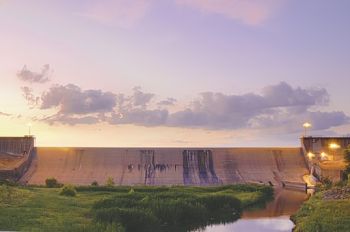Owner

|
| Iron Bridge Dam on Lake Tawakoni in Texas. |
"A state inspection program depends on dam owners and/or their consultants to provide complimentary and necessary inspections and surveillance. The dam owner and heirs, successor, or assigns is ultimately responsible for the safety of the dam. The owner is directly responsible for the ongoing operation, maintenance, surveillance, and periodic inspection. The owner shall do all of the following:
- Provide for on-going surveillance of the dam. The level of surveillance will depend on the size, condition, and hazard classification of the dam;
- Train their personnel in the basics of visual inspection techniques. Any person employed by the owner who regularly visits or works at the dam should be trained to inspect part or all of the dam and to report any observed problems;
- Measure or read appropriate instrumentation and record and evaluate the data at specified time frames;
- Promptly notify the the state dam safety program of any unusual observations. Unusual observations may be indications of distress;
- Inspect the dam and its appurtenances:
- On a regular periodic schedule based on size, condition, and consequence of failure, and;
- during and after any unusual loading including, but not limited to, significant storm/runoff events or earthquakes, to determine if structural or operational problems exist;
- Maintain records for the dam, including but not limited to construction plans and documents, engineering studies, inspection reports, monitoring records, photos, the emergency action plan, and the operation and maintenance manual;
- Obtain the services of an engineer or have qualified in-house staff to inspect the dam as required by state regulations."[1]
Examples
![]() Lesson Learned: A complete and thorough dam record is essential (DamFailures.org)
Lesson Learned: A complete and thorough dam record is essential (DamFailures.org)
Best Practices Resources
![]() Model State Dam Safety Program (FEMA P-316), FEMA, 2007
Model State Dam Safety Program (FEMA P-316), FEMA, 2007
Trainings
![]() On-Demand Webinar: The History of Dam Safety Governance in the US Including Risk Analysis
On-Demand Webinar: The History of Dam Safety Governance in the US Including Risk Analysis
![]() On-Demand Webinar: Human Factors in the Oroville Dam Spillway Incident
On-Demand Webinar: Human Factors in the Oroville Dam Spillway Incident
![]() On-Demand Webinar: Risk Communication for Dams
On-Demand Webinar: Risk Communication for Dams
![]() On-Demand Webinar: Human Factors in Dam Failure and Safety
On-Demand Webinar: Human Factors in Dam Failure and Safety
![]() On-Demand Webinar: How to Communicate Effectively in Any Situation
On-Demand Webinar: How to Communicate Effectively in Any Situation
![]() On-Demand Webinar: Tolerable Risk Guidelines for Dams: How Safe is Safe Enough
On-Demand Webinar: Tolerable Risk Guidelines for Dams: How Safe is Safe Enough
![]() On-Demand Webinar: Risk Assessment Basics for an Individual Dam
On-Demand Webinar: Risk Assessment Basics for an Individual Dam
![]() On-Demand Webinar: Risk Management for a Portfolio of Dams
On-Demand Webinar: Risk Management for a Portfolio of Dams
Citations:
Revision ID: 5032
Revision Date: 12/07/2022
